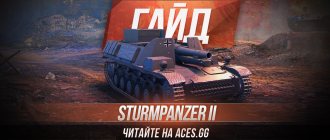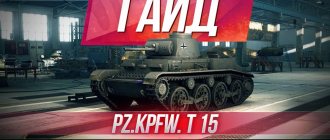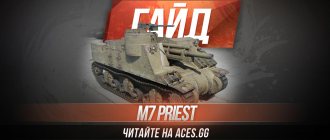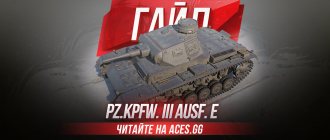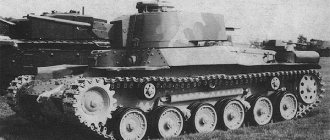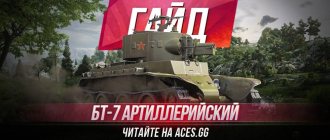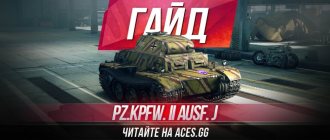Good day and welcome to aces.gg! Tankers, now we are bringing to your attention a vehicle that is quite unusual in appearance, but more than dangerous, the German Art-SPG of the third level - this is the Sturmpanzer I Bison guide
.
This device is characterized primarily by the fact that it has a rather unusual appearance; it is very similar to a cabinet and its dimensions are appropriate. I'll be honest, Sturmpanzer I Bison World of Tanks
not the most pleasant artillery, it has many serious shortcomings, but at the same time, in skillful hands, a self-propelled gun poses a great danger to enemy equipment.
Performance characteristics of Sturmpanzer I Bison
Let's start our acquaintance with this German woman with the fact that she has a very modest margin of safety and cannot boast of a good overview, since this parameter is equal to a pitiful 245 meters, which is bad even by artillery standards.
Regarding the topic of security Sturmpanzer I Bison WoT
, it is worth recalling once again its enormous, one might even say “barn-like” dimensions. First of all, because of this circumstance, camouflage indicators suffer, and besides this, we are easy to hit from any distance, and simply hiding from the approaching enemy will not be easy.
Despite the fact that we are the owners of such dimensions, the Sturmpanzer I Bison has characteristics
the bookings are just terrible. The huge cabin into which every enemy shell will fly is only 4 millimeters thick! But the hull, both in the frontal and side projections, is no better, since here you will not find a metal thickness of more than 21 millimeters, and even then taking into account the slope of the upper frontal part.
I would like to say that in our case everything is in order with mobility, however, here is the Art-SPG Bison WoT
not very good either. The fact is that the maximum speed and dynamics indicators are not bad, but the car accelerates and maintains the maximum speed very reluctantly. As for maneuverability, it is downright bad and you need to remember this.
gun
Due to the fact that in terms of general characteristics, the German artillery is clearly losing all ground, I would like to hope for weapons and I must say that our gun is really strong, although there are also serious shortcomings here.
Let's start with the fact that the Sturmpanzer I Bison
the weapon has powerful one-time damage, which without any problems gives us the opportunity to send enemies to the God of nuts and gears. But several unpleasant moments immediately emerge: a long reload and a small ammunition load.
If you pay attention to the armor penetration characteristics, Sturmpanzer I Bison art
again pleasantly surprising, since 35 millimeters of penetration by a landmine is one of the best indicators among third-level artillery, which allows you to confidently inflict damage.
Accuracy Sturmpanzer I Bison World of Tanks
received an exceptionally bad performance, and this is expressed in a huge spread, a very long convergence and, as is customary with self-propelled artillery systems, lack of stabilization.
The vertical and horizontal aiming angles deserve special attention, but they should be discussed separately. So, the German tank Sturmpanzer I Bison
received an excellent UVN, the gun not only tilts down by 4 degrees, but also excellently lifts up, thanks to which we get a very forward trajectory of the projectile and can hit even those opponents who are hiding behind some obstacle.
But the horizontal aiming angles are the complete opposite, because the Sturmpanzer I Bison tank
is capable of moving only 5.5 degrees, which is why you have to frequently re-align and have problems with aiming.
Links[edit]
- Chamberlain, Peter and Hilary L. Doyle. Thomas L. Jentz (technical editor). Encyclopedia of German Tanks of World War II: A Complete Illustrated Guide to German Battle Tanks, Armored Vehicles, Self-Propelled Guns and Half-Tracks, 1933–1945
. London: Arms and Armor Press, 1978 (revised 1993 edition) ISBN 1-85409-214-6. - Niehorster, Leo. German Organizational Series on World War II;
Volume 3/I: Mechanized Army Divisions (22 June 1941) Hanover, Germany: Niehorster, 1990 - Niehorster, Leo. German Organizational Series on World War II;
Volume 4/I: Mechanized Army Divisions (28 June 1942) Hanover, Germany: Niehorster, 1994 - Troika, Waldemar and Jaugitz, Markus. Sturmtiger and Sturmpanzer in battle
. Katowice, Poland: Model Hobby, 2008 ISBN 978-83-60041-29-1
Advantages and disadvantages
Since the most important general characteristics, as well as the weapon parameters of this artillery, have already been discussed, it is time to focus on its strengths and weaknesses. For better assimilation and understanding of the principles of the game on Sturmpanzer I Bison WoT
, now we will highlight its main advantages and disadvantages, breaking everything down point by point. Pros: • Powerful one-time damage; • High penetration rates; • Excellent horizontal aiming angles; • Ability to “throw” projectiles over obstacles; • Not bad maximum speed and dynamics. Cons: • Small visibility and HP reserve; • Very bad booking; • Large dimensions and poor camouflage; • Poor chassis turning speed; • Long recharge; • Mediocre accuracy; • Uncomfortable vertical aiming angles.
Modules
| Penetration (mm) | Damage (HP) | Rapid fire (rounds/min) | Spread (m/100m) | Mixing (c) | Weight, kg) | Price (|) | ||
| II | 15 cm sIG 33 L/11 | 75/75/228 | 200/300/300 | 3.85 | 0.55 | 5.14 | 760 | 4440 |
| Power (hp) | Fire probability (%) | Weight, kg) | Price (|) | ||
| I | Krupp M305 | 65 | 20 | 220 | 290 |
| II | Krupp M311 | 85 | 20 | 300 | 400 |
| II | Maybach HL 38 TR | 100 | 20 | 500 | 700 |
| Max. load (t) | Turning speed (gr/sec) | Rmin | Weight, kg) | Price (|) | ||
| I | Sturmpanzerketten I | 8.5 | 16 | 0 | 2000 | 280 |
| II | Sturmpanzerketten II | 8.9 | 18 | 0 | 2000 | 580 |
| Communication range (m) | Weight, kg) | Price (|) | ||
| II | FuG 2 | 265 | 40 | 180 |
| III | FuG 5 | 310 | 50 | 630 |
Equipment for Sturmpanzer I Bison
From all of the above, it is clearly visible that the car in our hands is really uncomfortable, there are many disadvantages and they are very significant. For this reason, it is important to properly equip it with additional modules, so the equipment for the Sturmpanzer I Bison tank
It’s better to install the following: 1. – this module gives the increase in reload speed necessary for our rate of fire, accordingly, you can deal more damage. 2. – our accuracy is also poor, this also applies to the aiming speed, which we will improve and will be able to aim a little more comfortably. 3. – improving camouflage in our case is an equally important goal, especially with such dimensions and stealth coefficient.
Combat use[edit]
SIG 33 auf Panzerkampfwagen I in Greece in 1941
Thirty-six vehicles were organized into the independent Schwere Infanteriegeschütz-Kompanie
(
mot.S.
) ("self-propelled heavy infantry gun companies") numbered 701–706, assigned to armored divisions in the Battle of France[1] as follows:[2]
- Company 701 to the 9th Panzer Division
- Company 702 to the 1st Tank Division
- Company 703 to the 2nd Tank Division
- Company 704 to the 5th Panzer Division
- Company 705 to the 7th Panzer Division
- Company 706 to the 10th Panzer Division
As part of the 5th Panzer Division, assigned to the German XIV Motorized Army Corps, the 704th Company participated in Operation Marita, the invasion of the Balkans. [3]
Later in 1941, the same assignment was retained for Operation Barbarossa, the invasion of the Soviet Union. [4] At this time, the 705th and 706th 7th and 10th Panzer Divisions were destroyed, respectively. [ citation needed
] Of the remaining companies, only the 701st participated in the opening phases of the subsequent Case Blue in 1942, although it and its mother 9th Armored Division were transferred to Army Group Center by the end of the summer of 1942. [5]
The last mention of these vehicles was from the 704th Company of the 5th Tank Division in mid-1943. [6]
Crew training
An even more important task will be to properly train the tank crews sitting inside the artillery, because there are much more opportunities here, which is why not only is there a higher probability of making a mistake, but also the benefits are more significant, especially in conjunction with the installed equipment. Thus, for the Artillery Self-propelled Gun Sturmpanzer I Bison, the perks are
it is better to distribute according to the following scheme: • Commander (radio operator) – , , , . • Gunner – , , , . • Driver mechanic - , , , . • Charger – , , , . • Charger – , , , .
Tactics for playing the Sturmpanzer I Bison
As has already been said many times, battles on our “buffalo” are far from comfortable, because the car is endowed with a large number of weaknesses that you need to try to neutralize, while using as many advantages of the car as possible.
I want to say right away that for the Sturmpanzer I Bison the tactics
conducting a battle involves taking the correct position, and in our case this factor plays a very important role. Due to not the best camouflage and huge dimensions, you need not only to stay away from the first line, but also to hide well, that is, sit in the bushes, or even better, with some small obstacle.
On Art-SPG Sturmpanzer I Bison WoT
It is also advisable to study the maps on which you will have to skate more than one battle as best as possible. This way you will be able to deal damage more confidently and will know in advance where it is better to converge at the beginning of the battle, so that bad horizontal aiming angles bother you less.
Our advantage is that Sturmpanzer I Bison art
can reach targets hidden behind hills, rocks, small buildings and other obstacles; let me remind you that this is possible thanks to excellent UGNs, which provide a very inclined projectile flight path. By the way, the farther you stand, the easier it will be to “throw”, but remember to limit the firing range.
Of course, the position will sooner or later lose its relevance, so in the intervals between shots the German tank Sturmpanzer I Bison
must move. Moreover, standing constantly at one point is dangerous, because this increases the likelihood that you will be detected.
Otherwise, you just have to act according to the circumstances, but remember the need to monitor the mini-map, and if you get caught in the light Bison World of Tanks
must hide as quickly as possible, while letting the enemy approach him is completely contraindicated due to the lack of armor and a very small margin of safety.
Sturmpanzer I Bison (full name 15 cm sIG 33 Sfl. auf Pz.KpfW.I Ausf B ohne Aufbau) is a self-propelled artillery unit on the chassis of the Pz.I Ausf.B light tank. This installation became one of the first self-propelled guns of the Wehrmacht. The main armament of the self-propelled gun was the 150-mm sIG33 infantry howitzer. In essence, the Sturmpanzer I Bison was a classic Waffentrager - a carrier of artillery weapons.
Perhaps one of the lessons of World War II was the implementation of the concept of self-propelled artillery, which became widespread. Such installations provided the infantry with fire support both in offensive and defensive situations. At the same time, ordinary infantry guns were first installed on the tracked chassis. Ultimately, by the end of the war, similar vehicles were available in the armies of all warring countries, but initially many of the self-propelled guns were only a product of improvisation. One of these products was the German Sturmpanzer I Bison. The installation of a 150 mm field howitzer along with wheels on a tracked chassis gave a special charm to this installation. This approach only led to an even greater overload of the base chassis, but it also had its advantages - it remained possible to use howitzers without a carrier in the event of breakdown or damage to the self-propelled gun chassis.
This self-propelled gun was not created from scratch, becoming a symbiosis of the chassis from the light German tank Pz. Kpfw. IB and 150 mm infantry howitzer sIG 33.
The question is what to do with light tanks Pz. Kpfw. I was raised more than once in Germany even before the start of World War II. The production of these tanks was discontinued by the beginning of 1939, and something had to be done with the released vehicles. The creation of an ammunition transporter and a command tank on the chassis of this tank was considered as various options; these projects were implemented in metal.
Another possible option for using the Pz chassis. Kpfw. I was the installation of powerful artillery weapons on it. After the Invasion of Poland, it became clear that towed heavy artillery often could not keep up with advancing tank and infantry units. The same was true for the retreat, when towing means were not always available, and it was simply unrealistic to roll heavy guns somewhere with the help of crews. At that time, one of the most powerful weapons at the disposal of the Wehrmacht was the 150-mm field howitzer sIG 33. Real combat operations only confirmed the German military leadership and designers that it was necessary to create a self-propelled artillery mount of a similar caliber, work on which were carried out at the end of 1939.
The technical characteristics of the self-propelled gun were in many ways similar to the tank, since they had a common Maybach HL38 TR engine, the maximum power of which was 100 hp at 3000 rpm. Weighing more than 8 tons, a self-propelled gun with such an engine could reach a speed of no more than 35 km/h on the highway; when driving over rough terrain, the speed dropped significantly - to 10-15 km/h. The gearbox has also not changed (5 forward speeds and 1 reverse). The fuel was stored in two tanks, its total supply was 146 liters.
When converting tanks into self-propelled artillery units, the turret was removed from them, and a 150-mm infantry howitzer sIG 33 was installed on the roof of the fighting compartment on steel supports along with wheels, a carriage and an armor shield. The crew and the gun were protected by an armored cabin, which was open from the stern and above. The sIG 33 gun was in production starting in 1933. By the beginning of World War II, the German army already had 410 such guns, and by the end of the war about 4,100 such howitzers had been assembled. The wheel axles of the 150-mm howitzer were attached to the wheelhouse of the self-propelled gun with a bolted connection, which made it possible to effectively fix the gun when firing, as well as in motion. Judging by the available photographs, radio stations could be installed on some self-propelled guns. The crew of the self-propelled gun consisted of 4 people: a driver, a commander who served as a gunner, and two loaders.
To simplify their task, German designers installed a 150-mm heavy field gun 15cm sIG33 (with a barrel length of 11 calibers) on the tank chassis directly with wheels, a carriage and a protective shield. The horizontal guidance sector was 25 degrees, vertical guidance angles could vary from -4 to +75 degrees. The ammunition that was carried on the self-propelled gun itself was very small - only 8 shots (6 of them in external baskets), so the self-propelled gun needed a vehicle that would transport ammunition. The howitzer had separate cartridge loading, which had a negative effect on the rate of fire - no more than 3 rounds per minute. However, even with such a rate of fire, the carried ammunition was consumed very quickly, almost instantly.
The initial speed of a high-explosive projectile of a 150-mm sIG33 howitzer weighing 38 kg did not exceed 240 m/s, but more was not required of it. Its impact on targets located in open areas, as well as on field fortifications, was very high. High-explosive shells have proven themselves to be effective during battles in urban environments. A cumulative 150-mm projectile weighing 25 kg had an initial speed of only 280 m/s, but its armor penetration reached 160 mm. This made it possible to fight any British, French or Soviet tanks of those years. But in close combat, the self-propelled gun was extremely vulnerable to enemy return fire.
The chassis remained unchanged and was completely borrowed from the Pz light tank. Kpfw. I B. For each side, it consisted of five road wheels with a rubber band, front drive and rear guide wheels. The self-propelled gun used a small-link caterpillar with steel tracks, the width of which was 280 mm.
Sturmpanzer I Bison in Greece, April-May 1941, the photo also shows the Sd.Kfz.10 half-track tractor and a soldier on a DKW NZ 350 motorcycle
Reworking the chassis of the Pz tanks. Kpfw. IB in the self-propelled howitzers Sturmpanzer I Bison was carried out by the Altmarkische Kettenfabrik (Alkett) company from Berlin. In total, 38 self-propelled guns of this type were assembled here. It is worth noting that in the future, 150-mm sIG 33 field howitzers continued to be installed on tank chassis, but for these purposes, the chassis of Pz tanks, which was more suitable in terms of carrying capacity, was used. Kpfw. II and the Czech tank Pz.Kpfw.38(t). The car, created on the basis of the latter, was called Grille.
36 Sturmpanzer I Bison self-propelled guns entered service with the 701-706th companies of self-propelled heavy infantry guns, 6 installations per company. All units reached a state of combat readiness in April 1940. One company each was included in 6 tank divisions that took part in the fighting in Belgium and France in May-June 1941. Each such company, according to the state of March 30, 1940, included, in addition to the Bisons themselves, 12 more one-ton Sd.Kfz.10 tractors, six trailers intended for transporting ammunition, 8 trucks, 8 cars, and 18 motorcycles. The unit's personnel consisted of two officers, 33 junior commanders and 116 privates.
Motorized units armed with these self-propelled howitzers were used as a mobile means of fire support for the German infantry. In battle, self-propelled guns were ordered to destroy and suppress enemy fortifications and firing points with fire, and to hit particularly important targets. All 6 companies took part in the hostilities against France, and, despite the good condition of the roads in Western Europe, the units suffered serious losses not from enemy fire, but from mechanical breakdowns. This was due to the large overload of the chassis of the light tank Pz. Kpfw. I, which became the basis for this self-propelled gun. As a result, in one of the companies the 150-mm howitzers were simply removed from the tank chassis and used in the traditional way. Later, on the Eastern Front, with its “developed” road network, where roads replaced directions, this practice became commonplace.
All 6 companies armed with Sturmpanzer I Bison self-propelled guns took part in Operation Barbarossa in June 1941. Due to the rapid change in the tactical situation at the front, these companies were very often used by the German command to solve tasks for which they were not designed. For example, the 705th company was used to fight Red Army tanks, and self-propelled guns were able to destroy 2 tanks. Crews from the 702nd company were also able to chalk up several destroyed Soviet tanks. During the battles, all self-propelled guns of this type were lost. The last of the Bisons were seen on the Eastern Front at least until March 1943; self-propelled guns of this type were still included in the 704th company.
In general, the Sturmpanzer I Bison self-propelled howitzer was not entirely successful; the conversion of its creation affected it. It was a kind of ersatz self-propelled gun project, which was designed and built in a short time. The self-propelled gun was tall, narrow and very heavy for the chosen chassis. In case of inept control, especially when driving over rough terrain, the car could easily overturn. The weight of 8.5 tons was a big disadvantage of the self-propelled gun, which was built on a tank chassis weighing 5.8 tons. Moreover, the tank chassis used were not new, but already worn out. Among other things, when firing from a howitzer, the self-propelled gun tilted very strongly with its stern, rolling back 1-1.5 meters - this created an additional load on the entire chassis structure. Of course, the German tank crews were not immediately enthusiastic about this vehicle, but the self-propelled gun was still suitable as a temporary means of supporting infantry and tanks in battle.
One “Bison” was captured by Red Army soldiers in the fall of 1941, and the installation was subjected to extensive testing. Taking into account the fact that tests of the captured StuG III Ausf.B assault gun were carried out in parallel, the 150-mm self-propelled howitzer on a light tank chassis did not arouse much interest among Soviet engineers, designers and military personnel. Rather, the effect was the opposite - the conclusion was made that the development of this kind of combat vehicles was inappropriate.
Tactical and technical characteristics of the Sturmpanzer I Bison: Overall dimensions: length - 4.67 m, width - 2.06 m, height - more than 2.8 m. Combat weight - 8.5 tons. Armor - 5-13 mm. The power plant is a 6-cylinder carburetor liquid-cooled engine with a power of 100 hp. Maximum speed - 35 km/h (on the highway), 15 km/h (over rough terrain). Cruising range - 140 km. Armament - 150-mm field howitzer sIG 33. Ammunition - 8 rounds (portable). Crew - 4 people.
